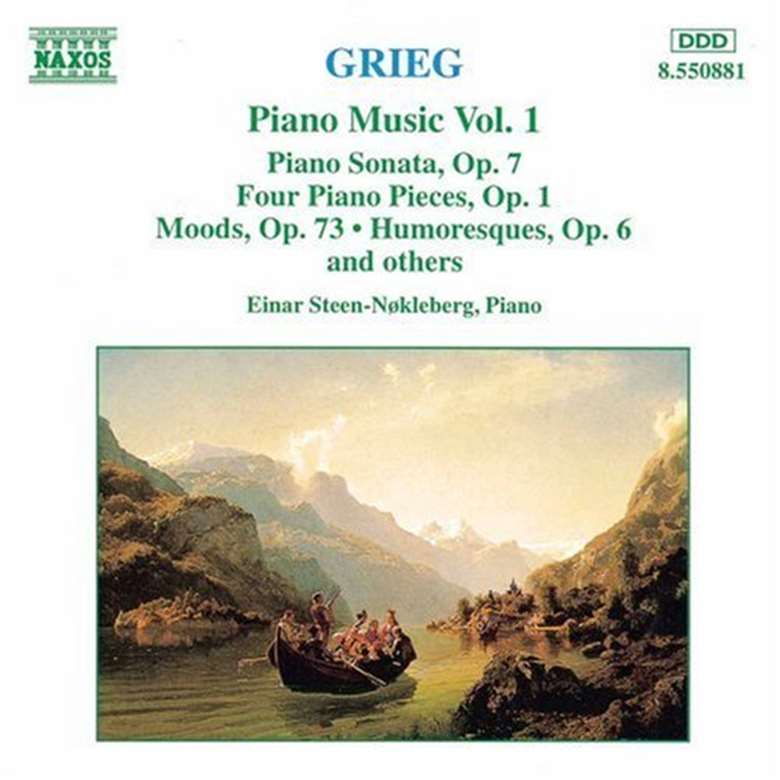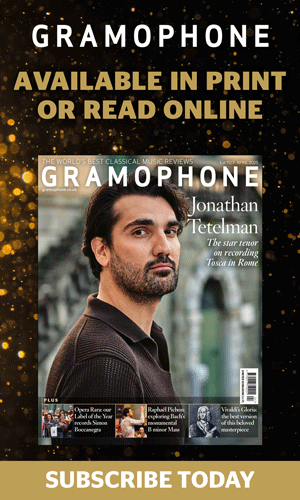Grieg's Piano Works
Monday, December 10, 2012

The Gramophone Choice
Vol 1: Piano Sonata in E minor, Op 7. Funeral March for Rikard Nordraak, CW117. Melodies of Norway – The Sirens’ Enticement. Stimmungen, Op 73. Transcriptions of Original Songs I, Op 41 – No 3, I love you. Four Humoresques, Op 6. Four Piano Pieces, Op 1
Einar Steen-Nøkleberg pf
Naxos 8 550881 (72‘ · DDD). Buy from Amazon
Vol 2: Two Improvisations on Norwegian Folksongs, Op 29. Melodies of Norway – A Ballad to Saint Olaf. 25 Norwegian Folksongs and Dances, Op 17. Transcriptions of Original Songs II, Op 52 – No 2, The First Meeting. 19 Norwegian Folksongs, Op 66
Einar Steen-Nøkleberg pf
Naxos 8 550882 (70‘ · DDD). Buy from Amazon
Vol 3: Four Album Leaves, Op 28. Six Poetic Tone‑pictures, Op 3. Melodies of Norway – Iceland. Three Pictures from Life in the Country, Op 19. Three Pieces from ‘Sigurd Jorsalfar’, Op 56 – Prayer. Ballade in G minor, Op 24, ‘in the form of variations on a Norwegian melody’
Einar Steen-Nøkleberg pf
Naxos 8 550883 (64‘ · DDD). Buy from Amazon
Vol 4: Holberg Suite, Op 40. Melodies of Norway – I went to bed so late. Six Norwegian Mountain Melodies, CW134. Peer Gynt Suite No 1, Op 46 – Morning. 17 Norwegian Peasant Dances, Op 72
Einar Steen-Nøkleberg pf
Naxos 8 550884 (71‘ · DDD). Buy from Amazon
These are the first four volumes of a complete Grieg cycle which stretches to no fewer than 14 discs. Einar Steen-Nøkleberg came to prominence during the 1970s and won numerous Norwegian and other prizes. He was professor of the piano at the Hanover Musikhochschule for a number of years and is the author of a monograph on Grieg’s piano music and its interpretation.
Volume 1: The first disc juxtaposes early pieces, the Sonata, Op 7, the Op 6 Humoresques and the Funeral March for Rikard Nordraak, all written in the mid-1860s, with his very last piano work, Stimmungen (‘Moods’), Op 73. He plays these bold and original pieces with great flair and understanding. Whatever its limitations there’s much greater range in Grieg’s piano music than is commonly realised and Steen-Nøkleberg is attuned to the whole spectrum it covers, ranging from the Bartókian ‘Mountaineer’s Song’ from Op 73 to the charm and innocence of the Allegretto con grazia, the third of the Humoresques, Op 6.
Volume 2: The Op 66 Norwegian Folksongs (1896) are remarkable pieces, as Grieg himself knew. He wrote to the Dutch composer, Julius Röntgen, of having ‘put some hair-raising chromatic chords on paper. The excuse is that they originated not on the piano but in my mind.’ Readers will recognise No 14 as the source of the theme for Delius’s On Hearing the First Cuckoo in Spring. Steen-Nøkleberg plays them with great tonal finesse and consummate artistry.
Volume 3: The most substantial work on this disc is the Ballade which Grieg wrote on his parents’ death. This recording can hold its own with the best in this healthy area of the catalogue – even if there are moments when Steen-Nøkleberg seems too discursive. Yet what an imaginative colour he produces in the Adagio variation when the music suddenly melts pianissimo.
Volume 4: The Norwegian Peasant Dances are amazing pieces for their period, and though their audacity and dissonance were later overtaken by Bartók, they still retain their capacity to surprise. The playing conveys the extraordinary character and originality of these pieces as do few others. The smaller pieces contained on this disc – as well as on its companions – are full of rewards.
Additional Recommendations
Lyric Pieces, Book 1, Op 12 – No 1, Arietta; No 2, Waltz; No 5, Folksong; No 6, Norwegian; Book 2, Op 38 – No 6, Elegy; No 7, Waltz; No 8, Canon; Book 4 Op 47 – No 2, Album Leaf; No 3, Melody; No 4, Norwegian Dance; Book 5, Op 54 – No 3, March of the Trolls; No 4, Nocturne; Book 6, Op 57 – No 2, Gade; No 3, Illusion; No 6, Homesickness; Book 7, Op 62 – No 1, Sylph; No 4, Brooklet; No 5, Phantom; No 6, Homeward; Book 8, Op 65 – No 6, Wedding Day at Troldhaugen; Book 9, Op 68 – No 3, At Your Feet; No 4, Evening in the Mountains; No 5, Cradle Song; Book 10, Op 71 – No 6, Gone; No 7, Remembrances
Leif Ove Andsnes pf
EMI 557296-2 (68‘ · DDD). Played on Grieg’s piano at the Grieg Troldhaugen Museum, Bergen. Buy from Amazon
Once again on home ground, Andsnes reminds you of his capacity to go directly to the heart of the matter. Taking you on a journey of increasing subtlety and introspection, he makes you aware that so much of this music is for those long winter nights. At the same time the music is so richly varied: the insistent dactylic rhythm of ‘Melody’ creates a strange unsettling poetic ambience, while the central oasis of calm in ‘Wedding Day at Troldhaugen’ would surely melt a heart of stone.
All Andsnes’s performances have that deceptive simplicity which is his touchstone. His playing is always sensitive, never sentimental and with a bracing and essential ‘touch of the codfish’ (Grieg) when required. And while one would never want to be without Gilels’s rapt DG performances (see below), praise could hardly be too high for a pianist who so enviably captures the poignant nature of a composer who Tchaikovsky once claimed had ‘a glance like a charming and candid child’. Grieg’s piano, with its distinctive timbre, provides an added touch of nostalgia.
Lyric Pieces, Book 1 – No 1, Arietta; Book 2 – No 1, berceuse; Book 3, Op 43 – No 1, Butterfly; No 2, Solitary Traveller; Book 4, Op 47 – No 2, Album Leaf; No 3, Melody; No 4, Halling; Book 5, Op 54 – No 4, Nocturne; No 5, Scherzo; Book 6, Op 57 – No 6, Homesickness; Book 7, Op 62 – No 4, Brooklet; No 6, Homeward; Book 8, Op 65 – No 5, Ballad; Book 9, Op 68 – No 2, Grandmother’s Minuet; No 3, At Your Feet; No 5, Cradle Song; Book 10, Op 71 – No 1, Once Upon a Time; No 3, Puck; No 6, Gone; No 7, Remembrances
Emil Gilels pf
DG The Originals 449 721-2GOR (56‘ · ADD). Recorded 1974. Buy from Amazon
Here, surely, is a classic recording, one of calibre and status for all time. Rarely can a great artist have declared his love with such touching candour. By his own admission, Gilels discovered in Grieg’s Lyric Pieces a ‘whole world of intimate feeling’ and at the sessions where these were recorded fought tirelessly to capture their intricate mix of innocence and experience. The results are of an unblemished purity, grace and contained eloquence. He brings the same insight and concentration to these apparent trifles as he did to towering masterpieces of the classic repertoire. The programme proceeds chronologically and one can appreciate the gradual but marked development in Grieg’s harmonic and expressive language – from the folksong-inspired early works to the more progressive and adventurous later ones. Gilels’s fingerwork is exquisite and the sense of total involvement with the music almost religious in feeling. Never can Debussy’s sniping estimate of Grieg, ‘a pink bonbon filled with snow’ (or DG’s dreary accompanying notes) have seemed wider of the mark. The recordings remain as impeccable as the playing. This is a disc for everyone’s desert island.
Lyric Pieces, Book 3, Op 43 – No 2, Solitary Traveller; No 6, To Spring; Book 4, Op 47 – No 2, Album Leaf; No 4, Halling; Book 5, Op 54 – No 3, March of the Trolls; No 5, Scherzo; Book 6, Op 57 – No 1, Vanished Days; No 2, Gade; No 6, Homesickness; Book 7, Op 62 – No 4, Brooklet; Book 8, Op 65 – No 6, Wedding Day at Troldhaugen; Book 9, Op 68 – No 3, At Your Feet. Holberg Suite, Op 40. Poetic Tone Pictures, Op 3
Katya Apekisheva pf
Quartz QTZ2061 (79’ · DDD). Buy from Amazon
Cards on the table: Katya Apekisheva is a young pianist who has already achieved artistic greatness. Not even Emil Gilels, in his legendary DG Grieg recital (see above), played more magically or, astonishingly, with greater finesse. How thrilled Irina Zaritskaya, Apekisheva’s teacher, would have been if she had lived to hear the fruit of her work with this profoundly gifted artist. A sonority of beguiling warmth and refinement and a rare poetic empathy quickly make you listen mesmerised as Apekisheva captures the very essence of Grieg’s genius.
Here, in her mixed programme, she tells you with an often painfully beautiful and unforced eloquence of how Grieg’s romantic temperament was easily clouded by depression and unease, of the way, for example in ‘Homesickness’ and ‘Vanished Days’, a heartbreaking state of mind is only temporarily modified by memories of happier times. The sense of the Lyric Pieces as Grieg’s confessional diary is everywhere in Apekisheva’s recital. In the Aria from the Holberg Suite she is deeply sensitive to the way Grieg’s love and respect for the 18th century is coloured by a near-Franckian chromaticism and dark introspection. These works and everything else on this beautifully recorded album suggest an artistic fervour and commitment given to very few in any generation.







